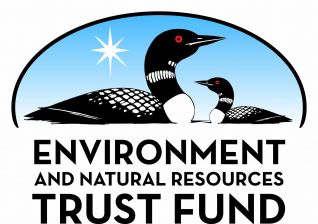Whitaker Treatment Wetlands
An engineered wetland in to treat polluted stormwater runoff at the headwaters of Lambert Creek.
This project was featured in the White Bear Press in September, 2018. Link to article.
Quick facts:
This is a sub-surface treatment wetland demonstration project adjacent to Whitaker Pond in White Bear Township, MN. Whitaker Pond captures drainage from a 640 acre area to the Northeast in White Bear Township and White Bear Lake. The land use within the watershed is approximately 90% urban (residential ~74%, School/Institutions ~11% and commercial ~4%), and runoff in the pond is shown to be impaired for nutrients and E. coli bacteria. Because the surface of Whitaker Pond is roughly 10-15 feet lower than the proposed location of the treatment wetland, a solar-powered pump will be used to send water up to the wetland cells (see map below). The wetland cells combined measure roughly 130' x 30'.
Funding:
This project received funding from the Environment and Natural Resources Trust Fund (ENRTF).

Reason for project:
Over 500 water bodies in Minnesota are impaired due to high levels of fecal coliform bacteria. Lambert Creek, which runs through the municipalities of White Bear Lake, White Bear Township, and Vadnais Heights has been listed on the State's Impaired Waters List for E. coli bacteria (primarily avian). Lambert Creek outlets into East Vadnais Lake, the drinking water reservoir for the City of St. Paul and surrounding communities. This project is a first of its kind in Minnesota and will investigate whether engineered wetlands are a viable option to reduce bacteria and nutrient levels in a water system. This research will build upon VLAWMO's existing bacteria source monitoring program analyzing bacteria DNA for effective treatment targeting. The project is located near Whitaker Pond, situated on the border of the City of White Bear Lake and White Bear Township.
Construction:
The project will deliver pollutant-laden storm water to three 10 x 40 foot experimental cells. Each cell contains a different media to test their effectiveness at removing pollutants, which is a valuable piece of research in the study.
- Control Cell: 80% washed clean concrete sand, 20% sphagnum fuscum peat. Blend is pH stabilized with lime. No plants above the cell.
- Experimental cell 1: 10% tire crumbs, 85% blend of (80-20) washed clean concrete sand and sphagnum fuscum peat, 5% silty clay, pH stabilized with lime. Cell planted with wetlands plants.
- Experimental cell 2: 20% tire crumbs, 75% blend of (80-20) washed clean concrete sand and sphagnum fuscum peat, 5% silty clay, pH stabilized with lime. Cell planted with wetlands plants.
Water is actually pumped from the system intake (see map below), and upward through the cells into the treatment wetland. The cells consist of (from the bottom up) an impermeable liner, followed by layers of gravel and sorption media and growth media. Sorption simply means the process by which one substance becomes attached to another. Unlike absorption, sorption focuses on the exchange of particles and materials as the water passes through. Sorption media is a "washed clean concrete" consisting of tire crumbs, limestone and high-iron sand. Growth media consists of expanded clay, vermiculite, and peat moss to promote plant growth. The top of each cell will be planted with plants found in Minnesota wetlands. One of the three cells will have no vegetation and will serve as a control. The total depth of each cell will be approximately 3-4'.
After stormwater flows from the pump and up through the experimental cells, it gets discharged to a "gallery" for groundwater recharge. The infiltration gallery is a layer of buried gravel that helps water drain into the underlying soil. A geotechnical investigation in the Winter of 2017 characterized the local subsurface soils and identified the allowable treated water infiltration rates. The unique vertical up-flow pattern in the experimental cells will maximize pollutant removal while maintaining wet conditions in the growth media to promote plant growth. A series of monitoring ports will be installed at the interfaces between the media in each experimental cell to determine the effectiveness of the media layers (as well as the overall effectiveness of each of experimental cell) in removing different pollutants commonly found in stormwater (E. coli bacteria, phosphorus, nitrate, and PAHs). The results of the experiment will be assessed for pollutant removal efficiencies and applicability for stormwater treatment best management practices throughout the state.
Results:
Whitaker Treatment Wetlands Final Report
Click here for a map of the project.
Click here to download the educational sign posted on-site.


